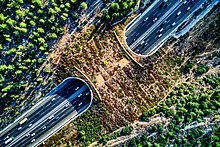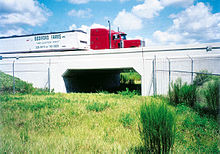
Back معبر الحياة البرية Arabic Ekodukt Czech Faunapassage Danish Grünbrücke German Paso de fauna Spanish Ökodukt Estonian محل عبور حیات وحش Persian Vihersilta Finnish Écoduc French מעבר אקולוגי HE


Wildlife crossings are structures that allow animals to cross human-made barriers safely. Wildlife crossings may include underpass tunnels or wildlife tunnels,[1] viaducts, and overpasses or green bridges[2] (mainly for large or herd-type animals); amphibian tunnels; fish ladders; canopy bridges (especially for monkeys and squirrels); tunnels and culverts (for small mammals such as otters, hedgehogs, and badgers); and green roofs (for butterflies and birds).[3]
Wildlife crossings are a practice in habitat conservation, allowing connections or reconnections between habitats, combating habitat fragmentation. They also assist in avoiding collisions between vehicles and animals, which in addition to killing or injuring wildlife may cause injury or death to humans and property damage.
Similar structures can be used for domesticated animals, such as cattle creeps.
- ^ Van Der Ree, Rodney; Heinze, Dean; McCarthy, Michael; Mansergh, Ian (December 2009). "Wildlife Tunnel Enhances Population Viability" (PDF). Ecology and Society. 14 (2): 7. doi:10.5751/ES-02957-140207. JSTOR 26268295. Archived (PDF) from the original on July 9, 2020.
- ^ "Green bridges: Safer travel for wildlife" (Press release). Natural England. July 31, 2015. Archived from the original on August 6, 2020.
- ^ "About Green Roofs: Advantages". Scandinavian Green Roof Association. Retrieved July 20, 2012.
In the places where there isn't enough ground space for green space, the green corridors, and the habitats for animals don't have to be discontinued, if the flat roofs are used.
© MMXXIII Rich X Search. We shall prevail. All rights reserved. Rich X Search